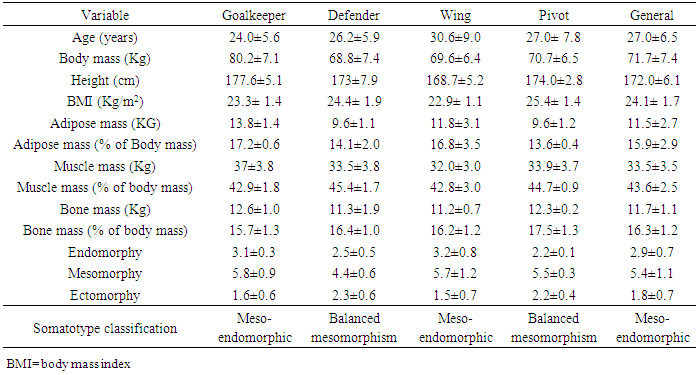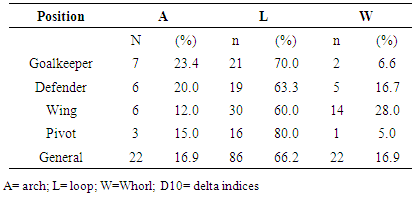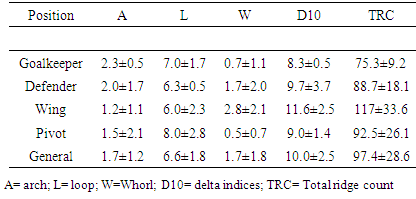-
Paper Information
- Previous Paper
- Paper Submission
-
Journal Information
- About This Journal
- Editorial Board
- Current Issue
- Archive
- Author Guidelines
- Contact Us
International Journal of Sports Science
p-ISSN: 2169-8759 e-ISSN: 2169-8791
2018; 8(3): 78-82
doi:10.5923/j.sports.20180803.02

Dermatoglyphic Profile and Body Composition of Athletes from the Brazilian Five-a-Side National Football Team
Glauber Lameira De Oliveira1, Talita Adão Perini De Oliveira1, João Rafael Valentim-Silva2, José Fernandes Filho1
1School of Physical Education and Sports, Federal University of Rio de Janeiro, Rio de Janeiro, Brazil
2Oswaldo Cruz Fundation, Federal University of Rondônia, Porto Velho, Rondônia, Brazil
Correspondence to: Glauber Lameira De Oliveira, School of Physical Education and Sports, Federal University of Rio de Janeiro, Rio de Janeiro, Brazil.
| Email: |  |
Copyright © 2018 The Author(s). Published by Scientific & Academic Publishing.
This work is licensed under the Creative Commons Attribution International License (CC BY).
http://creativecommons.org/licenses/by/4.0/

The knowledge of genetic markers and morphological variables in regards to the Paralympic Football Five-a-Side team is important since it can shape training strategies and enable the maximum potential of the athletes to be reached. The aim of the present study was to analyze the dermatoglyphic and body composition characteristics of athletes on the Brazilian Paralympic Five-A-Side National Football Team. A descriptive cross-sectional study was carried out with a sample composed of 13 athletes (27.0±6.5 years old, 71.7±7.4 kg) from the Brazilian Paralympic Five-A-Side National Football Team who participated in the Rio 2016 Paralympic Games. The dermatoglyphic data was collected using the protocol proposed by Cummins and Midlo. The methodology proposed by Heath-Carter was used to determine the somatotype. The study showed a high Loop pattern frequency (L) (66.2%) and low TRC (97.4 ± 28.6) and D10 averages (10.0 ± 2.5) for the general group. Goalkeepers, defender and pivots obtained a higher frequency of Loop (L) followed by Arch (A) with a reduction in Whorl values (W). Among the wings, there was a predominance of Loop (L) followed by Whorl (W) with reduction in the Arch (A). As for the somatotype in the different tactical positions at play, the study found that the defender (2.6-4.4- 2.4) and pivots (2.2-5.6-2.3) presented a balanced mesomorphic profile and the goalkeepers (3.2-5.8-1.6) and wings (3.2-5.7-1.6) a meso-endomorphic one. The Brazilian Paralympic Five-A-Side National Football Team has a genetic predisposition for the development of speed and strength. Wings also have a genetic predisposition for endurance. The somatotypic profile presented by the athletes indicates predominance of the muscular component for the Paralympic 5-A-Side football team, in all positions.
Keywords: 5-A-Side football, Somatotype, Dermatoglyphics, Body composition
Cite this paper: Glauber Lameira De Oliveira, Talita Adão Perini De Oliveira, João Rafael Valentim-Silva, José Fernandes Filho, Dermatoglyphic Profile and Body Composition of Athletes from the Brazilian Five-a-Side National Football Team, International Journal of Sports Science, Vol. 8 No. 3, 2018, pp. 78-82. doi: 10.5923/j.sports.20180803.02.
Article Outline
1. Introduction
- Football for the blind, 5-a-side football, is a new sport that only began to gain popularity in the 1990s with small tournaments and championships [11]. This sport was included in the Paralympic Games in Athens 2004 and since then the Brazilian team has been the champion in all the Paralympic editions through the present time. Although it is considered the best Paralympic team in the world, when it comes to training strategies for this sport, there is still a need for studies that verify them scientifically.The study of dermatoglyphic characteristics and morphological variables of athletes, although widely explored in Olympic sports [3, 10, 16, 19, 26] and in some Paralympic sports such as canoeing [23], track and field, cycling, judo, table tennis [8], swimming [25], goalball [1, 20] and football for people with cerebral palsy [9], 5-a-side football still lacks these investigations.According to Borin et al. [2] one of the concerns of sports sciences is to seek effective methodologies to identify an athlete’s profile in order to promote their maximum performance. The use of dermatoglyphics, therefore, presents itself as a tool for evaluating elite sports, since it shows hereditary characteristics, acting as a genetic marker. Since they do not depend on ethnicity and nationality, these genetic marks are informative, and can be used worldwide in the practice of sports to assist in the training of athletes [24].In the same way that genetic variables have been adopted to determine the characteristics that guide training tactics, body composition is an important measurement to determine the state of aptitude of each athlete and, depending on the training objective, can determine high-yield success [17, 18, 21]. In this way, the knowledge of genetic markers allied to morphological variables and to the physical qualities of athletes of a given sport and tactical position in a game situation, can optimize athletic preparation and increase the chances of superior performance [7].Such knowledge enables coaches, physical trainers and other professionals to be able to shape training considering the specifics of the athlete of a given sport and the tactical position that he or she occupies. Therefore, the aim of the present study was to analyze the dermatoglyphic and body composition characteristics of athletes of the Brazilian Paralympic five-a-side football team.
2. Methods
2.1. Participants
- A descriptive cross-sectional study was carried out, with a sample composed of 13 athletes (27.0 ± 6.5 years old, 71.7 ± 7.4 kg) from the Brazilian five-a-side football team, participants of the Rio 2016 Paralympic Games. Of these athletes, 10 are functionally classified as blind, type B1, that is, they have luminous perception with no possibility of identifying the object, according to the classification from the International Paralympic Committee [14]. Three other athletes are goalkeepers and classified as normovisual, who were not visually impaired.
2.2. Instruments and Procedures
- All the athletes participating in this study were submitted to an anthropometric evaluation, adopting standardized site marking and skin fold measuring techniques proposed by the International Society for the Advancement of Kinanthropometry (ISAK). In order to analyze body composition, the following measurements were performed: skinfold thickness (Cescorf, 0.1mm); body perimeters (flexible metal tape - Cardiomed, 1mm); bone diameters (Pachymeter, 1mm); height (Soehnle stadiometer, 0.5cm) and total body mass (Soehnle electronic scales, 100g). From these measurements, several parameters were calculated, including those relevant to this study: body mass index (BMI = total body mass/height2, kg/m2), bone mass, muscle mass, sum of nine cutaneous folds (biceps, triceps, subscapular, midaxillary, suprailiac, chest, abdomen and leg, mm), body fat (%) and somatotype. The percentage of fat was obtained using the Siri equation [22] after estimating body density using the equation developed by Jackson & Pollock [15]. In order to determine the somatotype, the methodology proposed by Heath-Carter [12] was used.The data was collected the morning before a training session, on the premises of the Benjamin Constant Institute (IBC), in Rio de Janeiro, during the team’s preparation for the Rio 2016 Paralympics. Acquisition of the anthropometric data was performed by an experienced evaluator with an acceptable Anthropometric Technical Error of Measurement (TEM) of 5%, guaranteeing the reliability of the measurements.To the dermatoglyphic collection of the distal phalanges of the fingers, a collector was used with typographic ink (Sirchie; Model PM283PIP) according to the protocol from Cummins and Midlo [6]. Fingerprint collection allowed for the identification of the Arch (A), Loop (L) and Whorl (W) dermatoglyphic patterns, as well as the dermatoglyphic delta indices (D10) and total ridge count (TRC), by trained researchers from the Laboratory of Biosciences of Human Motricity (LABIMH- UFRJ).
2.3. Ethical Aspects
- This study complied with the ethical norms in research with human beings and was approved by the Ethics and Research Committee of the Clementino Fraga Filho University Hospital (CEP-HUCFF-UFRJ) of the Federal University of Rio de Janeiro, under approval number 1.707.380, in compliance with the provisions of Resolution 466 of the National Council of Health from December 12, 2012 for research with human beings.
2.4. Statistical Analysis
- The data was analyzed using SPSS statistical software, version 21.0, 2009 (SPSS Inc., IBM, Chicago). The descriptive statistics consisted of mean, standard deviation and relative frequency values.
3. Results
- Table 1 presents the general characteristics and body composition of five-a-side football players in different tactical positions, with values expressed as mean and standard deviation.
|
|
|
4. Discussion
- This study is the first one that sought to investigate the body composition and dermatoglyphic characteristics of a world-class five-a-side football team. This study becomes important since determining the aforementioned characteristics can become an important tool for the planning of high performance sport training; small improvements in performance may represent the difference between first, second and third place, or even other lower positions.The results available in Table 1, which present the variables of body composition of the athletes from different tactical positions, show that there was proximity between most of the average values presented by the wings and goalkeepers, as well as between the defender and pivots.This result was confirmed by the somatotypic classification obtained by the athletes from these positions since both the wings and goalkeepers were classified as having a meso-endomorphic profile and defender and pivots as having a balanced mesomorph profile.It is worth noting that regardless of the tactical position among the athletes evaluated, in this study there was a predominance of the muscular component in relation to the other somatotypic components. The meso-endomorphic somatotypic profile obtained by the team, considering athletes from all positions, is the same found for athletes from this sport in a previous study [11].Similar mean values were obtained in the present study for the anthropometric and body composition variables compared to those presented by athletes from the same sport in a previous study [11], such that these athletes are within the standard presented for this sport. Campos et al. [4] evaluated the body composition of seven five-a-side football athletes and obtained mean values of body mass, height, body mass index and body fat close to the mean values presented in the present study group. It should be noted, however, that the team evaluated by these researchers was restricted to athletes in the wing, pivot and defender positions, excluding goalkeepers, which may have contributed to the lower mean value of body fat obtained in the sample, since Gorla et al. [11] verified that athletes from this position have presented values significantly higher for this variable in comparison with the other athletes.These findings indicate a greater genetic predisposition to velocity as a determinant physical quality in the evaluated team. A similar characteristic was found by Fernandes and Fernandes Filho [9] with outdoor football players with cerebral palsy (L = 6.5±2.7) and by Dantas, Alonso & Fernandes Filho [7] upon investigation of futsal athletes from the 2001 Brazilian National League, (L = 6.6±2.89).Souza et al., [24] investigated the intensity of effort among five-a-side football athletes and found that during 52.5% of the total time of a match their intensity of effort was between zone 2 and zone 3, with a mean of 89.8% of maximum heart rate. Thus, although different studies have shown similar results in regards to the genetic predisposition for speed among soccer, futsal and five-a-side football athletes, this study presented evidence that the required intensity of effort in five-a-side football is greater than in soccer and futsal [24].The whorl presented by the wings accompanying the high frequency of loop, unlike the other positions, represents the quality of endurance required by this position. Campos et al., [5] affirm that the wings are usually the players with greatest aerobic resistance, in order to bear larger displacements, while defender and pivots tend to present a greater level of force, which justifies the results found in this study.Although the team evaluated has a lower genetic predisposition for the development of quality physical coordination, since they have a high loop pattern frequency (Table 2) and low mean TRC and D10 (Table 3), this team has indices characteristic of sports requiring speed and strength [13], which are important for five-a-side football.The technical actions performed by the athletes during a game of this sport, in general, are characterized by the variation of displacements and explosive actions with a high level of speed and strength. Thus, these athletes present the qualities potentially required by this modality, enabling their optimal performance.The dermatoglyphic indices of the athletes participating in this study, laid out in Table 3, were classified using the set of indices proposed by Dantas et al., [9] for somato-functional classification. Regarding TRC analysis, the mean value obtained indicates different physical qualities according to the tactical positions in play. Thus, goalkeepers were classified in class I, presenting a high genetic predisposition for strength, and defender, wings and pivots fit similarly into class II, with a predisposition for strength and speed. These physical qualities are important features of five-a-side football.One limitation presented by this study is the lack of researches carried out with a dermatoglyphic approach involving Football Five-a-Side athletes, making it impossible to compare the present results with those of other studies.Involving five-a-side football athletes with visual deficiencies makes it impossible to compare the present results with values from other studies.
5. Conclusions
- Regarding the dermatoglyphic characteristics, the team presented genetic predisposition for developing speed and strength, physical qualities required by this sport. In relationship to the body composition, the study found similarities between wings and goalkeepers, as well as between the defender and pivots for most variables. The somatotypic profile presented by the athletes indicates the predominance of the muscular component in all the tactical positions played in the game, corroborating the dermatoglyphic findings presented by the team.Future studies on high-level athletes of this sporting modality are recommended with a focus on genetic and morphological variables in order to allow for comparisons. In addition, it is important to add to the studies other types of genotypic markers in order to provide subsidies to the physical preparation of the athletes guiding their specialized training and allowing for maximum performance of the athletes of this Paralympic sport.
ACKNOWLEDGEMENTS
- To the athletes who participated in this study and to the Brazilian Confederation of Sports for the Visually Impaired (CBDV).
 Abstract
Abstract Reference
Reference Full-Text PDF
Full-Text PDF Full-text HTML
Full-text HTML

